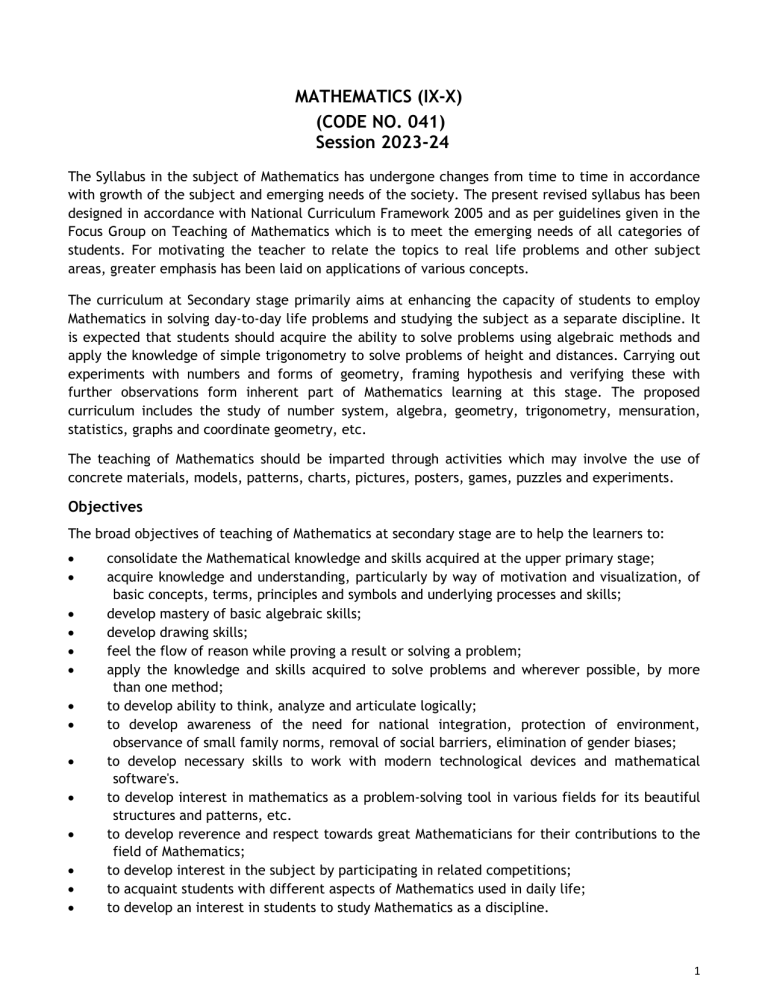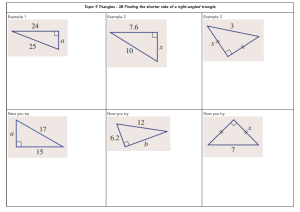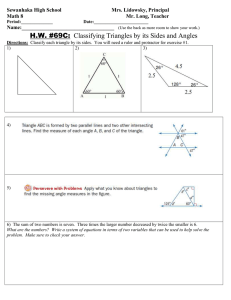
MATHEMATICS (IX-X) (CODE NO. 041) Session 2023-24 The Syllabus in the subject of Mathematics has undergone changes from time to time in accordance with growth of the subject and emerging needs of the society. The present revised syllabus has been designed in accordance with National Curriculum Framework 2005 and as per guidelines given in the Focus Group on Teaching of Mathematics which is to meet the emerging needs of all categories of students. For motivating the teacher to relate the topics to real life problems and other subject areas, greater emphasis has been laid on applications of various concepts. The curriculum at Secondary stage primarily aims at enhancing the capacity of students to employ Mathematics in solving day-to-day life problems and studying the subject as a separate discipline. It is expected that students should acquire the ability to solve problems using algebraic methods and apply the knowledge of simple trigonometry to solve problems of height and distances. Carrying out experiments with numbers and forms of geometry, framing hypothesis and verifying these with further observations form inherent part of Mathematics learning at this stage. The proposed curriculum includes the study of number system, algebra, geometry, trigonometry, mensuration, statistics, graphs and coordinate geometry, etc. The teaching of Mathematics should be imparted through activities which may involve the use of concrete materials, models, patterns, charts, pictures, posters, games, puzzles and experiments. Objectives The broad objectives of teaching of Mathematics at secondary stage are to help the learners to: consolidate the Mathematical knowledge and skills acquired at the upper primary stage; acquire knowledge and understanding, particularly by way of motivation and visualization, of basic concepts, terms, principles and symbols and underlying processes and skills; develop mastery of basic algebraic skills; develop drawing skills; feel the flow of reason while proving a result or solving a problem; apply the knowledge and skills acquired to solve problems and wherever possible, by more than one method; to develop ability to think, analyze and articulate logically; to develop awareness of the need for national integration, protection of environment, observance of small family norms, removal of social barriers, elimination of gender biases; to develop necessary skills to work with modern technological devices and mathematical software's. to develop interest in mathematics as a problem-solving tool in various fields for its beautiful structures and patterns, etc. to develop reverence and respect towards great Mathematicians for their contributions to the field of Mathematics; to develop interest in the subject by participating in related competitions; to acquaint students with different aspects of Mathematics used in daily life; to develop an interest in students to study Mathematics as a discipline. 1 COURSE STRUCTURE CLASS –IX Units I II III IV V VI Unit Name NUMBER SYSTEMS ALGEBRA COORDINATE GEOMETRY GEOMETRY MENSURATION STATISTICS Total Marks 10 20 04 27 13 06 80 UNIT I: NUMBER SYSTEMS 1. REAL NUMBERS (18) Periods 1. Review of representation of natural numbers, integers, and rational numbers on the number line. Rational numbers as recurring/ terminating decimals. Operations on real numbers. 2. Examples of non-recurring/non-terminating decimals. Existence of non-rational numbers (irrational numbers) such as , and their representation on the number line. Explaining that every real number is represented by a unique point on the number line and conversely, viz. every point on the number line represents a unique real number. 3. Definition of nth root of a real number. 4. Rationalization (with precise meaning) of real numbers of the type and (and their combinations) where x and y are natural number and a and b are integers. 5. Recall of laws of exponents with integral powers. Rational exponents with positive real bases (to be done by particular cases, allowing learner to arrive at the general laws.) UNIT II: ALGEBRA 1. POLYNOMIALS (26) Periods Definition of a polynomial in one variable, with examples and counter examples. Coefficients of a polynomial, terms of a polynomial and zero polynomial. Degree of a polynomial. Constant, linear, quadratic and cubic polynomials. Monomials, binomials, trinomials. Factors and multiples. Zeros of a polynomial. Motivate and State the Remainder Theorem with examples. Statement and proof of the Factor Theorem. Factorization of ax2 + bx + c, a ≠ 0 where a, b and c are real numbers, and of cubic polynomials using the Factor Theorem. Recall of algebraic expressions and identities. Verification of identities: + and their use in factorization of polynomials. 2 2. LINEAR EQUATIONS IN TWO VARIABLES (16) Periods Recall of linear equations in one variable. Introduction to the equation in two variables. Focus on linear equations of the type ax + by + c=0.Explain that a linear equation in two variables has infinitely many solutions and justify their being written as ordered pairs of real numbers, plotting them and showing that they lie on a line. UNIT III: COORDINATE GEOMETRY COORDINATE GEOMETRY (7) Periods The Cartesian plane, coordinates of a point, names and terms associated with the coordinate plane, notations. UNIT IV: GEOMETRY 1. INTRODUCTION TO EUCLID'S GEOMETRY (7) Periods History - Geometry in India and Euclid's geometry. Euclid's method of formalizing observed phenomenon into rigorous Mathematics with definitions, common/obvious notions, axioms/postulates and theorems. The five postulates of Euclid. Showing the relationship between axiom and theorem, for example: (Axiom) 1. Given two distinct points, there exists one and only one line through them. (Theorem) 2. (Prove) Two distinct lines cannot have more than one point in common. 2. LINES AND ANGLES (15) Periods 1. (Motivate) If a ray stands on a line, then the sum of the two adjacent angles so formed is 180O and the converse. 2. (Prove) If two lines intersect, vertically opposite angles are equal. 3. (Motivate) Lines which are parallel to a given line are parallel. 3. TRIANGLES (22) Periods 1. (Motivate) Two triangles are congruent if any two sides and the included angle of one triangle is equal to any two sides and the included angle of the other triangle (SAS Congruence). 2. (Prove) Two triangles are congruent if any two angles and the included side of one triangle is equal to any two angles and the included side of the other triangle (ASA Congruence). 3 3. (Motivate) Two triangles are congruent if the three sides of one triangle are equal to three sides of the other triangle (SSS Congruence). 4. (Motivate) Two right triangles are congruent if the hypotenuse and a side of one triangle are equal (respectively) to the hypotenuse and a side of the other triangle. (RHS Congruence) 5. (Prove) The angles opposite to equal sides of a triangle are equal. 6. (Motivate) The sides opposite to equal angles of a triangle are equal. 4. QUADRILATERALS (13) Periods 1. (Prove) The diagonal divides a parallelogram into two congruent triangles. 2. (Motivate) In a parallelogram opposite sides are equal, and conversely. 3. (Motivate) In a parallelogram opposite angles are equal, and conversely. 4. (Motivate) A quadrilateral is a parallelogram if a pair of its opposite sides is parallel and equal. 5. (Motivate) In a parallelogram, the diagonals bisect each other and conversely. 6. (Motivate) In a triangle, the line segment joining the mid points of any two sides is parallel to the third side and in half of it and (motivate) its converse. 5. CIRCLES (17) Periods 1.(Prove) Equal chords of a circle subtend equal angles at the center and (motivate) its converse. 2.(Motivate) The perpendicular from the center of a circle to a chord bisects the chord and conversely, the line drawn through the center of a circle to bisect a chord is perpendicular to the chord. 3. (Motivate) Equal chords of a circle (or of congruent circles) are equidistant from the center (or their respective centers) and conversely. 4.(Prove) The angle subtended by an arc at the center is double the angle subtended by it at any point on the remaining part of the circle. 5.(Motivate) Angles in the same segment of a circle are equal. 6.(Motivate) If a line segment joining two points subtends equal angle at two other points lying on the same side of the line containing the segment, the four points lie on a circle. 7.(Motivate) The sum of either of the pair of the opposite angles of a cyclic quadrilateral is 180° and its converse. UNIT V: MENSURATION 1. AREAS (5) Periods Area of a triangle using Heron's formula (without proof) 2. SURFACE AREAS AND VOLUMES (17) Periods Surface areas and volumes of spheres (including hemispheres) and right circular cones. 4 UNIT VI: STATISTICS STATISTICS (15) Periods Bar graphs, histograms (with varying base lengths), and frequency polygons. MATHEMATICS QUESTION PAPER DESIGN CLASS – IX (2023-24) Time: 3 Hrs. Max. Marks: 80 S. Typology of Questions No. Total Marks % Weightage (approx.) 1 Remembering: Exhibit memory of previously learned material by recalling facts, terms, basic concepts, and answers. Understanding: Demonstrate understanding of facts and ideas by organizing, comparing, translating, interpreting, giving descriptions, and stating main ideas 43 54 2 Applying: Solve problems to new situations by applying acquired knowledge, facts, techniques and rules in a different way. 19 24 18 22 80 100 Analysing : Examine and break information into parts by identifying motives or causes. Make inferences and find evidence to support generalizations 3 Evaluating: Present and defend opinions by making judgments about information, validity of ideas, or quality of work based on a set of criteria. Creating: Compile information together in a different way by combining elements in a new pattern or proposing alternative solutions Total INTERNAL ASSESSMENT Pen Paper Test and Multiple Assessment (5+5) Portfolio Lab Practical (Lab activities to be done from the prescribed books) 20 MARKS 10 Marks 05 Marks 05 Marks 5 COURSE STRUCTURE CLASS –X Units I II III IV V VI VII Unit Name Marks 06 20 06 15 12 10 11 80 NUMBER SYSTEMS ALGEBRA COORDINATE GEOMETRY GEOMETRY TRIGONOMETRY MENSURATION STATISTICS & PROBABILTY Total UNIT I: NUMBER SYSTEMS 1. REAL NUMBER (15) Periods Fundamental Theorem of Arithmetic - statements after reviewing work done earlier and after illustrating and motivating through examples, Proofs of irrationality of UNIT II: ALGEBRA 1. POLYNOMIALS (8) Periods Zeros of a polynomial. Relationship between zeros and coefficients of quadratic polynomials. 2. PAIR OF LINEAR EQUATIONS IN TWO VARIABLES Pair of linear equations in two solution, consistency/inconsistency. variables and (15) Periods graphical method of their Algebraic conditions for number of solutions. Solution of a pair of linear equations in two variables algebraically - by substitution, by elimination. Simple situational problems. 3. QUADRATIC EQUATIONS (15) Periods Standard form of a quadratic equation ax2 + bx + c = 0, (a ≠ 0). Solutions of quadratic equations (only real roots) by factorization, and by using quadratic formula. Relationship between discriminant and nature of roots. Situational problems based on quadratic equations related to day to day activities to be incorporated. 6 4. ARITHMETIC PROGRESSIONS (10) Periods Motivation for studying Arithmetic Progression Derivation of the nth term and sum of the first n terms of A.P. and their application in solving daily life problems. UNIT III: COORDINATE GEOMETRY Coordinate Geometry (15) Periods Review: Concepts of coordinate geometry, graphs of linear equations. Distance formula. Section formula (internal division). UNIT IV: GEOMETRY 1. TRIANGLES (15) Periods Definitions, examples, counter examples of similar triangles. 1. (Prove) If a line is drawn parallel to one side of a triangle to intersect the other two sides in distinct points, the other two sides are divided in the same ratio. 2. (Motivate) If a line divides two sides of a triangle in the same ratio, the line is parallel to the third side. 3. (Motivate) If in two triangles, the corresponding angles are equal, their corresponding sides are proportional and the triangles are similar. 4. (Motivate) If the corresponding sides of two triangles are proportional, their corresponding angles are equal and the two triangles are similar. 5. (Motivate) If one angle of a triangle is equal to one angle of another triangle and the sides including these angles are proportional, the two triangles are similar. 2. CIRCLES (10) Periods Tangent to a circle at, point of contact 1. (Prove) The tangent at any point of a circle is perpendicular to the radius through the point of contact. 2. (Prove) The lengths of tangents drawn from an external point to a circle are equal. 7 UNIT V: TRIGONOMETRY 1. INTRODUCTION TO TRIGONOMETRY (10) Periods Trigonometric ratios of an acute angle of a right-angled triangle. Proof of their existence (well defined); motivate the ratios whichever are defined at 0 and 90 . Values of the trigonometric ratios of 300, 450 and 600. Relationships between the ratios. o 2. o TRIGONOMETRIC IDENTITIES (15) Periods Proof and applications of the identity sin2A + cos2A = 1. Only simple identities to be given. 3. HEIGHTS AND DISTANCES: Angle of elevation, Angle of Depression. (10)Periods Simple problems on heights and distances. Problems should not involve more than two right triangles. Angles of elevation / depression should be only 30°, 45°, and 60°. UNIT VI: MENSURATION 1. AREAS RELATED TO CIRCLES (12) Periods Area of sectors and segments of a circle. Problems based on areas and perimeter / circumference of the above said plane figures. (In calculating area of segment of a circle, problems should be restricted to central angle of 60°, 90° and 120° only. 2. SURFACE AREAS AND VOLUMES (12) Periods Surface areas and volumes of combinations of any two of the following: cubes, cuboids, spheres, hemispheres and right circular cylinders/cones. UNIT VII: STATISTICS AND PROBABILITY 1. STATISTICS (18) Periods Mean, median and mode of grouped data (bimodal situation to be avoided). 2. PROBABILITY (10) Periods Classical definition of probability. Simple problems on finding the probability of an event. 8 MATHEMATICS-Standard QUESTION PAPER DESIGN CLASS – X (2023-24) Time: 3 Hours S. No. Typology of Questions Max. Marks: 80 Total Marks % Weightage (approx.) Remembering: Exhibit memory of previously learned material by recalling facts, terms, basic concepts, and answers. 1 2 43 54 19 24 18 22 80 100 Understanding: Demonstrate understanding of facts and ideas by organizing, comparing, translating, interpreting, giving descriptions, and stating main ideas Applying: Solve problems to new situations by applying acquired knowledge, facts, techniques and rules in a different way. Analysing : Examine and break information into parts by identifying motives or causes. Make inferences and find evidence to support generalizations 3 Evaluating: Present and defend opinions by making judgments about information, validity of ideas, or quality of work based on a set of criteria. Creating: Compile information together in a different way by combining elements in a new pattern or proposing alternative solutions Total INTERNAL ASSESSMENT 20 MARKS Pen Paper Test and Multiple Assessment (5+5) 10 Marks Portfolio 05 Marks Lab Practical (Lab activities to be done from the prescribed books) 05 Marks 9 MATHEMATICS-Basic QUESTION PAPER DESIGN CLASS – X (2023-24) Time: 3Hours S. No. Max. Marks: 80 Typology of Questions Total Marks % Weightage (approx.) Remembering: Exhibit memory of previously learned material by recalling facts, terms, basic concepts, and answers. 1 60 75 Understanding: Demonstrate understanding of facts and ideas by organizing, comparing, translating, interpreting, giving descriptions, and stating main ideas 2 Applying: Solve problems to new situations by applying acquired knowledge, facts, techniques and rules in a different way. 12 15 3 Analysing : Examine and break information into parts by identifying motives or causes. Make inferences and find evidence to support generalizations Evaluating: Present and defend opinions by making judgments about information, validity of ideas, or quality of work based on a set of criteria. Creating: Compile information together in a different way by combining elements in a new pattern or proposing alternative solutions 8 10 80 100 Total INTERNAL ASSESSMENT 20 MARKS Pen Paper Test and Multiple Assessment (5+5) 10 Marks Portfolio 05 Marks Lab Practical (Lab activities to be done from the prescribed books) 05 Marks PRESCRIBED BOOKS: 1. Mathematics - Textbook for class IX - NCERT Publication 2. Mathematics - Textbook for class X - NCERT Publication 3. Guidelines for Mathematics Laboratory in Schools, class IX - CBSE Publication 4. Guidelines for Mathematics Laboratory in Schools, class X - CBSE Publication 5. Laboratory Manual - Mathematics, secondary stage - NCERT Publication 6. Mathematics exemplar problems for class IX, NCERT publication. 7. Mathematics exemplar problems for class X, NCERT publication. 10



